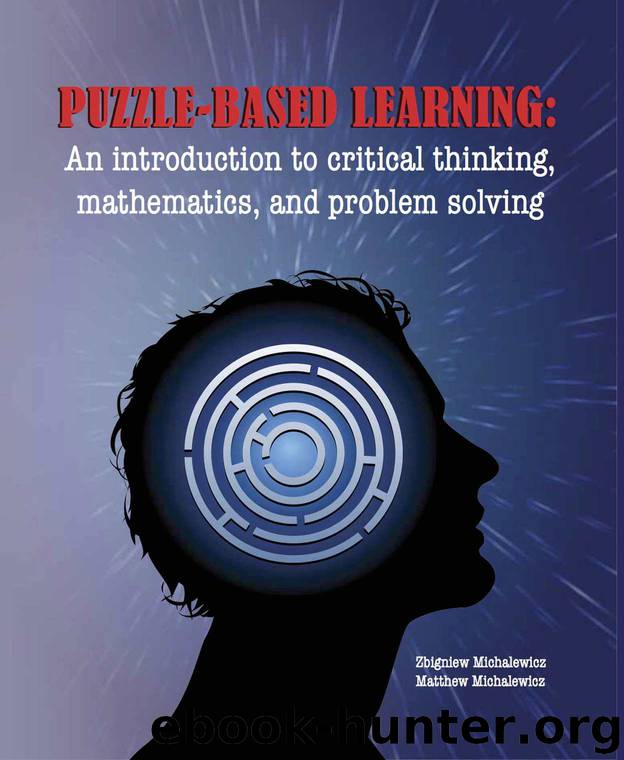Puzzle-Based Learning (3rd Edition): An Introduction to Critical Thinking, Mathematics, and Problem Solving by Michalewicz Zbigniew & Michalewicz Matthew

Author:Michalewicz, Zbigniew & Michalewicz, Matthew [Michalewicz, Zbigniew]
Language: eng
Format: epub
ISBN: 978-0-9922861-9-4
Publisher: Credibility Corporation Pty Ltd
Published: 2014-04-22T16:00:00+00:00
These two tables are quite consistent and indicate that enrolment in the introductory course Elementary Physics improves the grade for Principles of Physics (Phys 301) by 10 points (80 versus 70 for engineering students and 95 versus 85 for arts students).
So, let us combine these data sets into two larger data sets: one for students who took Elementary Physics before taking Phys 301:
and the other for students who did not take Elementary Physics before taking Phys 301:
In both cases, the average grade for Phys 301 has been determined by adding all the grade points (e.g., 4,475 in the case of students who took Elementary Physics earlier) and dividing them by the total number of students (55). The results in the last two tables clearly indicate that students who took Elementary Physics performed worse than those who did not by 2.3 points (81.4 versus 83.6). This is the opposite conclusion to that of the first two tables. Why?
Obviously, by combining the data sets we have produced a misleading conclusion, but why? The answer has two parts. First, the data sets for the two major groups (engineering and art students) were influenced by a hidden variable: course difficulty. The engineering students received a rigorous course, whereas art students received a less demanding version. Secondly, the sizes of the combined data sets were not the same. This caused the average of Phys 301 grades to be weighted toward the engineering student grades for those who had taken Elementary Physics . Since the engineering students’ course was more rigorous, it lowered the average. The opposite was true for the combined results of those who did not take Elementary Physics .
Note that there were four separate groups in this study:
1. Engineering students who took Elementary Physics .
2. Engineering students who did not take Elementary Physics .
3. Arts students who took Elementary Physics .
4. Arts students who did not take Elementary Physics .
If all the four groups had been the same size, the results would have indicated that students who took Elementary Physics performed better by 10 points in Phys 301.
Simpson’s paradox is caused by the combination of hidden variables and unequally sized groups being combined into a single data set. Combining unequally sized groups, in the presence of hidden variables, can weight the results incorrectly. This can lead to seriously flawed conclusions. The obvious way to prevent this is to not combine data sets of different sizes from different sources …
There are a few good stories about a statistician on a plane. One of them is about a statistician who took a bomb onto the plane, as he reasoned that the probability of there being two bombs on a plane is much lower than the probability of there being just one bomb – so his flight would be safer! The other story is embedded into the following puzzle:
Puzzle 8.8
100 people line up to board a plane; one of them is a statistician, who was at the end of the line. The first person in line lost his boarding pass.
Download
This site does not store any files on its server. We only index and link to content provided by other sites. Please contact the content providers to delete copyright contents if any and email us, we'll remove relevant links or contents immediately.
Modelling of Convective Heat and Mass Transfer in Rotating Flows by Igor V. Shevchuk(6391)
Weapons of Math Destruction by Cathy O'Neil(6142)
Factfulness: Ten Reasons We're Wrong About the World – and Why Things Are Better Than You Think by Hans Rosling(4694)
Descartes' Error by Antonio Damasio(3230)
A Mind For Numbers: How to Excel at Math and Science (Even If You Flunked Algebra) by Barbara Oakley(3217)
Factfulness_Ten Reasons We're Wrong About the World_and Why Things Are Better Than You Think by Hans Rosling(3199)
TCP IP by Todd Lammle(3134)
Fooled by Randomness: The Hidden Role of Chance in Life and in the Markets by Nassim Nicholas Taleb(3044)
Applied Predictive Modeling by Max Kuhn & Kjell Johnson(3018)
The Tyranny of Metrics by Jerry Z. Muller(3000)
The Book of Numbers by Peter Bentley(2909)
The Great Unknown by Marcus du Sautoy(2646)
Once Upon an Algorithm by Martin Erwig(2598)
Easy Algebra Step-by-Step by Sandra Luna McCune(2582)
Lady Luck by Kristen Ashley(2532)
Practical Guide To Principal Component Methods in R (Multivariate Analysis Book 2) by Alboukadel Kassambara(2497)
Police Exams Prep 2018-2019 by Kaplan Test Prep(2484)
All Things Reconsidered by Bill Thompson III(2355)
Linear Time-Invariant Systems, Behaviors and Modules by Ulrich Oberst & Martin Scheicher & Ingrid Scheicher(2333)
